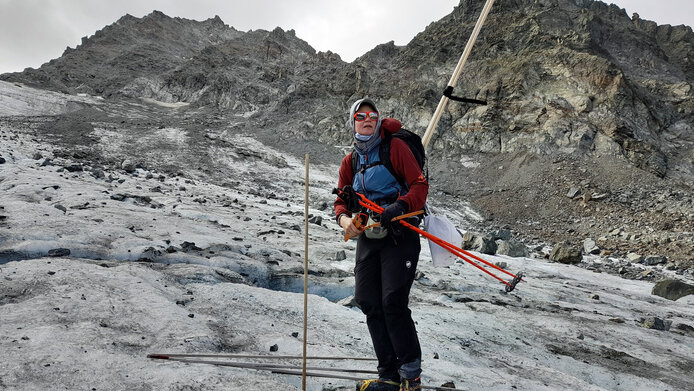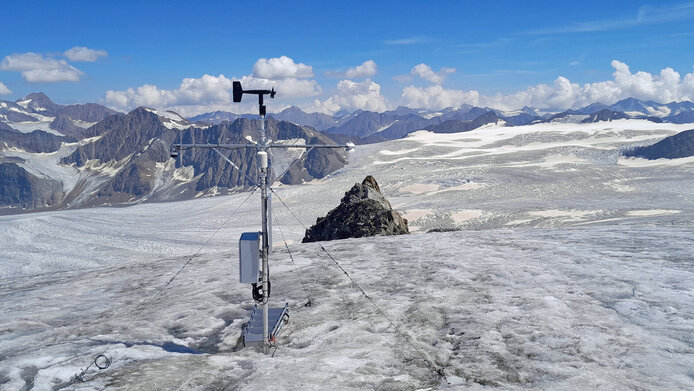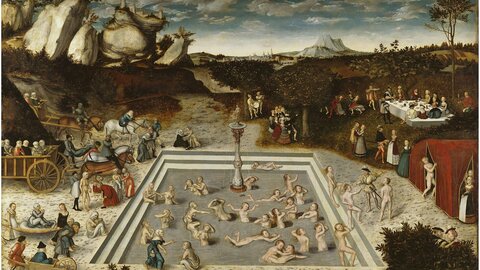When the glaciers turn dark

There are few places where the consequences of the man-made climate crisis are becoming more conspicuously clear than on the glaciers in the Eastern Alps. According to forecasts, some smaller glaciers will be lost in just a few years. And even if global warming is limited to 1.5 degrees Celsius, only some remnants of the white giants will be left by the end of this century. So, Austria's glaciers seem to have a bleak future – but how exactly can one predict it?
The solar radiation that hits the surface of the glacier supplies energy that makes the ice melt. “In order to understand more precisely how glaciers will evolve, it is important to better understand the albedo,” says glaciologist Lea Hartl from the Institute of Interdisciplinary Mountain Research (IGF) at the Austrian Academy of Sciences (ÖAW). Albedo is a technical term for a unit of measurement that describes how much solar radiation the surface of the glacier reflects.
Glaciers laid bare
“If a glacier is covered by snow, therefore white, its surface reflects solar energy. The darker it is, the greater the proportion of light that is absorbed and thereby promotes the melting of the glacier,” explains Hartl. The problem with this? If the protective snow cover is missing, the melting progresses faster. “Most of the glaciers in Austria and the Eastern Alps are now bare in summer,” notes Lea Hartl. In the project “Glacier Albedo: In-Situ Processes and Remote Sensing”, she is investigating how the reflectivity and thus the future of glaciers can be better captured and predicted.
There are several factors, which can occur all at the same time, that influence how dark the glacier ice gets, and, thus, how quickly it will melt. Liquid water that collects on the glacier surface in years of intense melting darkens parts of the glacier surface and accelerates the melting process. Particles deposited on the snow, firn or ice of the glacier also darken the surface. These darkening particles can be organic, such as pollen and algae, or inorganic, such as rock dust. Some, like dust particles from the Sahara, are blown in from far afield. Others come from the nearby surroundings or, like ice algae, even live there. These small microorganisms form a brown pigment that makes the glacier surface appear pink from a distance.
The project
To better predict what will happen to glaciers in the future, we need to know more about the various factors causing them to melt. A team led by Lea Hartl is combining measurements taken from glacier surfaces with data from satellite images to learn more about how and why the white giants are disappearing.
Up the scale and back again
The Gepatschferner glacier in the Kaunertal valley in Tyrol is very well known to Lea Hartl and she has already conducted numerous field studies there. With the current FWF-funded project she now wants to find out what actually darkens the ice. A long-term measuring station operated by the Austrian Academy of Sciences that also includes a weather station is collecting data series at the Gepatschferner. From this data the glaciologist learns how the reflectivity of the ice surface changes. In collaboration with colleagues, Lea Hartl wants to investigate how much this affects glacier melting. “Another aim of the project is to find out how to incorporate locally collected knowledge into existing glacier models and create a better link between local measurements and global models,” she notes.
Images from space
In addition to the data from the Kaunertal, the researcher also draws on openly available geo-satellite data, including so-called true-color images provided by the earth observation satellites Sentinel-2A and Sentinel-2B of the EU COPERNICUS space program. “On these images, you can see how the reflected radiation decreases over dark areas in a certain wavelength range, which means that the radiation is absorbed in these places,” explains Lea Hartl. The satellite data can also be used to determine the albedo of the glacier surface.
The satellite data’s spatial resolution is not high enough, however, to capture very small-scale processes. In addition, the satellites pass over specific locations such as the Gepatschferner glacier only about once a week and clouds can restrict the view of the glacier. Given that the reflectivity of the glacier surface can change from day to day and also over the course of a day, for example when surface meltwater forms on warm, sunny days, Lea Hartl combines data with different resolutions. At present she is comparing the satellite data with data from the weather station at Gepatschferner. “I'm interested in whether the data from the weather station can be used to validate the albedo value provided by the satellite data,” Hartl explains.
Aircraft data
There is further evidence provided by a research aircraft from the University of Zurich, which flew over the Gepatschferner in the fall of 2024. The researchers took an image of the glacier with an imaging spectrometer installed on the aircraft. “Each of the individual pixels in this image shows an entire spectral curve – i.e. values of 300 to 400 color bands per pixel,” says Lea Hartl. By comparison: the Sentinel-2 satellites deliver 13 color bands.
Hartl is evaluating the extent to which the results of this high-resolution data differ from those of the satellites. “It is important to know this, for if there is not much added value we can continue to work with the openly and globally available satellite data. If differences do indeed exist, we know then that we need more precise data from the ice surface in order to record certain processes,” she explains.
Having researched the local glaciers for years, Hartl has witnessed how dark they have already become. The year 2022 was a particularly bad year for the glaciers and involved heavy melting. This was partly due to the fact that the firn cover melted, which left the ice exposed, and partly because the surface was dark. “Both the data from the weather station and the satellite data showed us that there were phases in previous years when the ice was as dark as the stones next to it,” reports Lea Hartl.
Doing puzzles on the ice
Snow conditions permitting, the glaciologist wants to collect more data during this summer. She will carry a spectroradiometer (a light measuring device) in her backpack and conduct spot measurements on the Gepatschferner for a detailed record of the reflective properties of the ice surface. In combination with data from the weather station, this will enable her to draw conclusions about how the darkening of the glacier surface changes throughout the day.
“I really enjoy putting the different elements together,” says Lea Hartl. “Sometimes you come with a certain notion in your head, but it doesn't really fit with what you find on site. Then you have to think about where you went wrong and what the measurement data show us instead. It's like a big, complicated puzzle.” The research project will be completed in May 2026 when most of the puzzle pieces will be in place. The first publication from the project will be published soon. The knowledge that Lea Hartl is gathering through data at the Gepatschferner can help to show how bleak the future looks for the glaciers.
Personal details
Lea Hartl studied meteorology, geophysics and physical geography at the University of Innsbruck, where she completed her doctorate on the effects of climate change on rock glaciers. Holding a position of senior postdoc at the Institute for Interdisciplinary Mountain Research (IGF) of the Austrian Academy of Sciences (ÖAW) in Innsbruck, the glaciologist conducts research on ice albedo and rock glaciers and contributes to research at the Hyperspectral Imaging Laboratory of the University of Alaska Fairbanks, USA.
The project “Glacier albedo: in-situ processes & remote sensing footprints“ (2023-2026) receives EUR 294,000 in funding from the Austrian Science Fund FWF under its ESPRIT funding track.
Publications
Recent observations and glacier modeling point towards near-complete glacier loss in western Austria (Ötztal and Stubai mountain range) if 1.5 °C is not met, The Cryosphere 2025
Loss of accumulation zone exposes dark ice and drives increased ablation at Weißseespitze, Austria, EGUsphere 2025, Preprint






